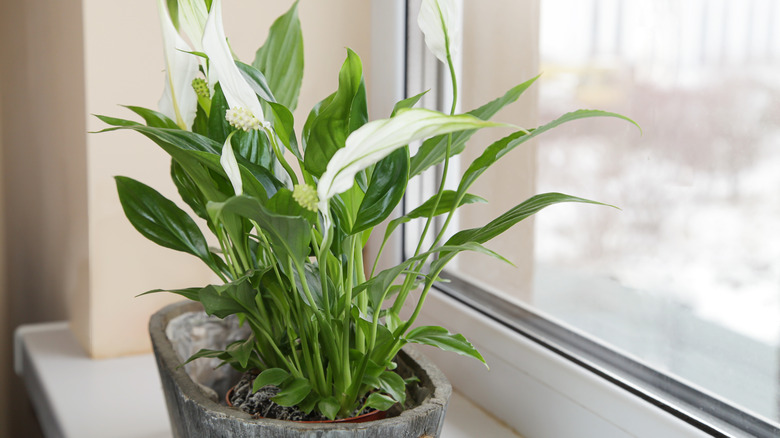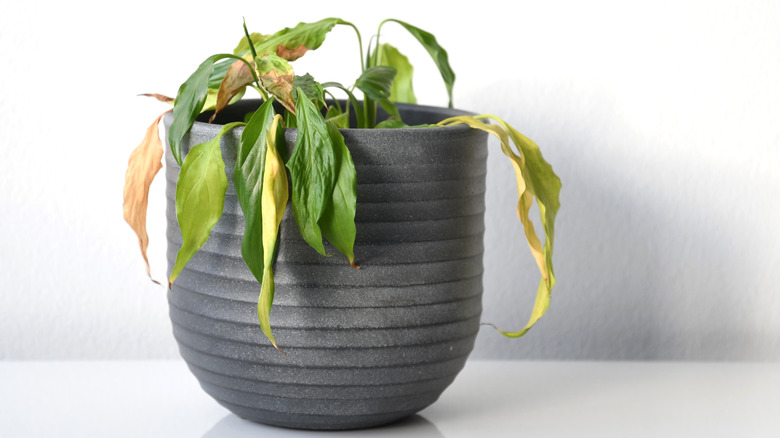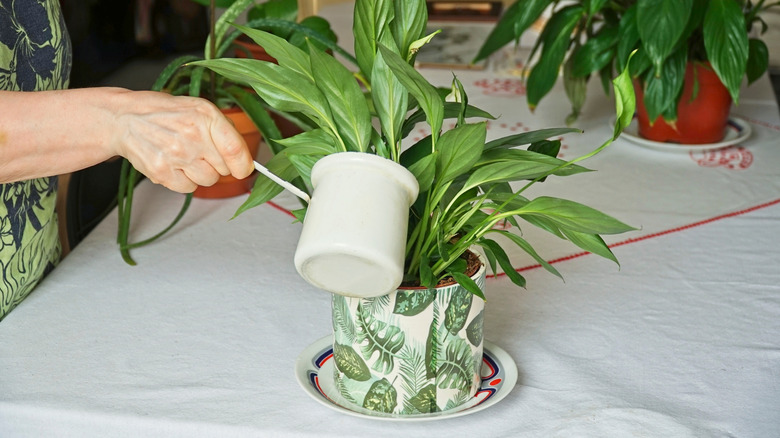Telltale Signs You're Underwatering Your Peace Lily Plant
When it comes to houseplant care, overwatering gets a lot of attention. The advice to avoid overwatering is one of the first tips plant parents will find when they're bringing a new potted beauty home or trying to diagnose a problem. But underwatering can be just as much of a problem, leading to wilted leaves, dead stem tips, and your plant looking dehydrated overall. You'll want to watch out for underwatering in tropical plants especially, which thrive in moist soil.
Peace lilies (Spathiphyllum), are one such plant that will suffer from wilted leaves, browning leaf tips, and droopy blooms when they've been underwatered. If the leaves have a brittle or crispy texture and they perk up after a drink, you can tell underwatering is the most likely problem.
Even though peace lilies require some soil moisture to keep them happy, don't go overboard! Keep that soil from getting overly soggy and make sure it's draining well. Some signs, such as yellowing leaves, can point to both underwatering and overwatering, but you can use your senses and some simple tools to learn whether the soil has too much or too little moisture. For peace lilies in shallower pots, feeling the first two inches of soil with your finger can help you find this out, but in deeper pots, try picking them up to gauge if they feel heavy, or stick a wooden dowel further into the soil and observe whether it gets wet. Another plant problem that can be confused for underwatering is when the older leaves yellow due to a nitrogen deficiency. If the soil feels normal but these leaves still turn yellow, try pruning and adding in a fertilizer made for houseplants.
How to tell if your peace lily is underwatered
In the event that the leaves of your peace lily start browning at their tips, wilt, and feel papery, the signs point to an underwatered plant. The white flowers can sometimes sag as well in dry conditions. And if you've had this houseplant for a while, its older leaves might turn yellow, or even fall off, when it gets parched. The time of year can also be a clue toward whether your tropical friend needs water. Humidity in the air is lower during the winter, so that's a time to be extra careful about the soil becoming too dry. If the soil lacks moisture, the plant's drooping leaves should perk back up after you water them.
When it's very dehydrated, you can remove the plant from the pot and put it in a basin filled with water, where the roots can soak up what they need. Then put the plant back in its usual container and monitor whether the it springs back over the next day. You can also leave the plant in its pot and submerge it in a bigger container of water for up to 10 minutes, depending on the pot size. To make sure the houseplant isn't wasting energy, trim off any leaves that remain crisped or discolored.
How to prevent underwatering a peace lily
How can you make sure your peace lilies get the precise amount of hydration they need, threading the needle between overwatering and underwatering? Thankfully, many other indoor gardeners have thought of solutions. From adding soil amendments to changing up the watering method or adding humidity, there are several options to prevent underwatering.
Watering peace lilies from the bottom is an easy technique you can use for nonstop blooms on this plant. Peace lilies respond well when their roots can drink water from a saucer set beneath their main container. If you're using this method, make sure to empty the saucer of any water the plant doesn't absorb, so it's not sitting in a puddle and at risk for root disease.
Another approach involves mixing in coir, pine bark, vermiculate, or other organic materials that help the soil retain enough water. Finally, you can use a little-known gravel trick to help peace lilies flourish. Place a tray with pebbles or gravel under their pots, so the plants will stay humid without getting waterlogged.


